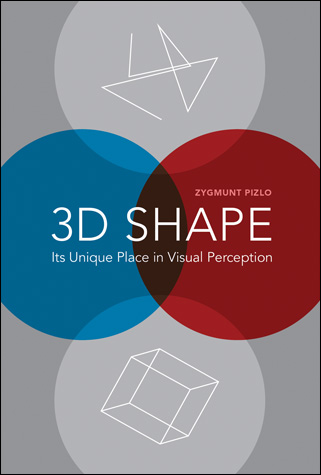|
|
|

|
3D
Shape
Its Unique Place in Visual Perception
|
|
|
|
 |
Zygmunt Pizlo
ISBN-10: 0-262-16251-2
ISBN-13: 978-0-262-16251-7
MIT
Press
|
Summary
The uniqueness of shape as a perceptual property
lies in the fact that it is both complex and
structured. Shapes are perceived
veridically--perceived as they really are in the
physical world, regardless of the orientation from
which they are viewed. The constancy of the shape
percept is the sine qua non of shape
perception; you are not actually studying shape if
constancy cannot be achieved with the stimulus you
are using. Shape is the only perceptual attribute
of an object that allows unambiguous
identification. In this first book devoted
exclusively to the perception of shape by humans
and machines, Zygmunt Pizlo describes how we
perceive shapes and how to design machines that
can see shapes as we do. He reviews the long
history of the subject, allowing the reader to
understand why it has taken so long to understand
shape perception, and offers a new theory of
shape.
Until recently, shape was treated in combination
with such other perceptual properties as depth,
motion, speed, and color. This resulted in
apparently contradictory findings, which made a
coherent theoretical treatment of shape
impossible. Pizlo argues that once shape is
understood to be unique among visual attributes
and the perceptual mechanisms underlying shape are
seen to be different from other perceptual
mechanisms, the research on shape becomes coherent
and experimental findings no longer seem to
contradict each other. A single theory of shape
perception is thus possible, and Pizlo offers a
theoretical treatment that explains how a
three-dimensional shape percept is produced from a
two-dimensional retinal image, assuming only that
the image has been organized into two-dimensional
shapes.
Pizlo focuses on discussion of the main concepts,
telling the story of shape without interruption.
Appendixes provide the basic mathematical and
computational information necessary for a
technical understanding of the argument.
References point the way to more in-depth reading
in geometry and computational vision.
Recent Papers:
Pizlo, Z., Li, Y. & Steinman, R.M. (2008)
Binocular disparity only comes into play when
everything else fails; a finding with broader
implications than one might suppose. Spatial
Vision, 21, 495-508.
Li, Y., Pizlo, Z. & Steinman, R.M. (2009) A
computational model that recovers the 3D shape
of an object from a single 2D retinal
representation. Vision Research 49,
979-991.
Troscianko, T., Benton, C.P., Lovell, P.G.,
Tolhurst, D.J. & Pizlo, Z. (2009) Camouflage
and visual perception. Philosophical
Transactions of the Royal Society B 364,
449-461.
Pizlo, Z., Sawada, T., Li, Y., Kropatsch, W.G.
& Steinman, R.M. (2009) New approach to the
perception of 3D shape based on veridicality,
complexity, symmetry and volume. Minireview. Vision
Research (in press).
Book Reviews
Schofield, Andrew (2009) Perception, 38,
630-632.
Schwartz, Robert (2009) American Journal of
Psychology, 122, 561-565.
Content of the Book
- Early Theories of Shape and the First
Experiments on Shape Constancy
- The Cognitive Revolution Leads to
Neo-Gestaltism and Neo-Empiricism
- Machine Vision
- Formalisms Enter into the Study of Shape
Perception
- A New Paradigm for Studying Shape Perception
Book Order
This book can be ordered on line at the MIT
Press web site.
|
|
|
|